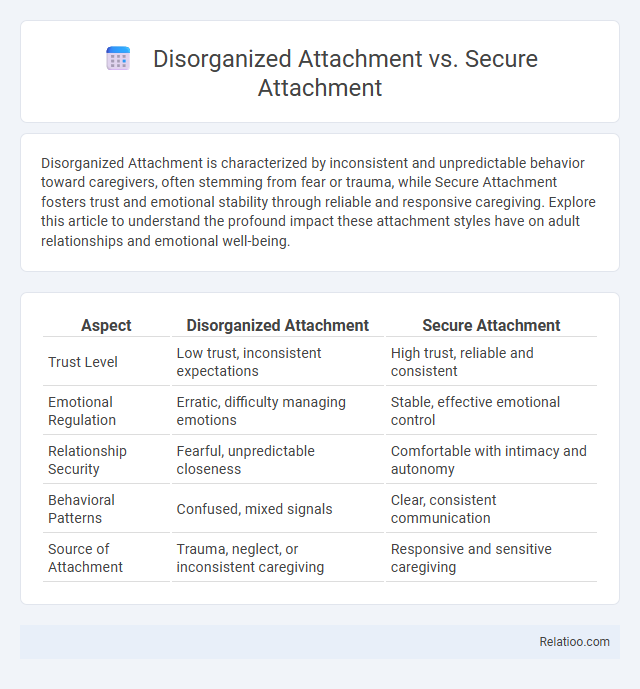Disorganized Attachment is characterized by inconsistent and unpredictable behavior toward caregivers, often stemming from fear or trauma, while Secure Attachment fosters trust and emotional stability through reliable and responsive caregiving. Explore this article to understand the profound impact these attachment styles have on adult relationships and emotional well-being.
Table of Comparison
| Aspect | Disorganized Attachment | Secure Attachment |
|---|---|---|
| Trust Level | Low trust, inconsistent expectations | High trust, reliable and consistent |
| Emotional Regulation | Erratic, difficulty managing emotions | Stable, effective emotional control |
| Relationship Security | Fearful, unpredictable closeness | Comfortable with intimacy and autonomy |
| Behavioral Patterns | Confused, mixed signals | Clear, consistent communication |
| Source of Attachment | Trauma, neglect, or inconsistent caregiving | Responsive and sensitive caregiving |
Understanding Attachment Styles: Disorganized vs Secure
Disorganized attachment is characterized by inconsistent and confused behavior toward caregivers, often resulting from trauma or neglect, leading to difficulties in emotional regulation and relationship building. Secure attachment forms when caregivers provide consistent support and responsiveness, fostering trust and healthy emotional development. Understanding the differences between disorganized and secure attachment is crucial for addressing developmental challenges and promoting psychological well-being.
Defining Disorganized Attachment
Disorganized attachment is characterized by a lack of clear attachment behavior, often resulting from a caregiver's inconsistent or frightening responses, leading to confusion and anxiety in the child. Secure attachment, in contrast, involves consistent, responsive caregiving that fosters trust and healthy emotional bonds, supporting your child's confidence and social development. Understanding these distinctions helps identify the root causes of behavioral challenges linked to disorganized attachment, promoting targeted interventions for emotional regulation.
Characteristics of Secure Attachment
Secure attachment is characterized by trust, effective communication, and emotional regulation, allowing individuals to form healthy, lasting relationships. Unlike disorganized attachment, which involves confusion and inconsistent behaviors, securely attached individuals display confidence in exploring their environment while seeking comfort from caregivers when needed. This secure bond fosters resilience, social competence, and balanced self-esteem throughout life.
Early Childhood Factors Influencing Attachment
Early childhood factors influencing attachment include caregiver responsiveness, consistency, and emotional availability, which shape whether a child develops secure or disorganized attachment patterns. Secure attachment arises when caregivers provide reliable comfort and support, fostering a sense of safety in Your child's relationships. In contrast, disorganized attachment often results from inconsistent, neglectful, or frightening caregiving, leading to confusion and difficulty in managing emotions.
Emotional and Behavioral Outcomes
Disorganized attachment often results in conflicting emotional responses, such as fear and confusion, leading to unpredictable behavior patterns like withdrawal or aggression. Secure attachment fosters emotional resilience and consistent social interactions, enabling you to form healthy relationships and effectively regulate stress. Attachment styles fundamentally influence your emotional well-being and behavioral adaptations throughout life.
Impact on Relationships in Adulthood
Disorganized attachment in adulthood often leads to difficulty in forming stable, trusting relationships due to internal conflicts and fear of abandonment, whereas secure attachment fosters healthy communication, emotional regulation, and intimacy. Individuals with secure attachment typically experience greater relationship satisfaction, resilience during conflicts, and consistent emotional support. Attachment styles significantly influence adult relationship dynamics, with disorganized attachment linked to higher vulnerability to dysfunction and secure attachment promoting relational stability and well-being.
Signs and Symptoms to Look For
Disorganized attachment is characterized by inconsistent behaviors, such as fearfulness mixed with seeking comfort, alongside difficulty regulating emotions and confusion in relationships. Secure attachment shows signs like comfort with intimacy, effective communication, and healthy emotional regulation, indicating a positive sense of trust and safety with caregivers. Your awareness of these signs helps identify whether attachment patterns impact emotional well-being and relationship dynamics.
Parenting Styles That Shape Attachment
Parenting styles deeply influence the development of disorganized, secure, and other attachment types by shaping a child's emotional security and trust. Secure attachment forms when parents are consistently responsive and sensitive to Your needs, fostering confidence and healthy relationships. Conversely, disorganized attachment arises from unpredictable or frightening parenting behaviors, leading to confusion and emotional dysregulation in a child's attachment style.
Therapeutic Approaches for Disorganized Attachment
Therapeutic approaches for disorganized attachment emphasize trauma-informed care and creating a stable therapeutic environment to repair disrupted attachment patterns. Interventions such as Dyadic Developmental Psychotherapy (DDP) and Eye Movement Desensitization and Reprocessing (EMDR) are effective in fostering safety and emotional regulation in clients with disorganized attachment. In contrast, secure attachment therapy focuses on reinforcing existing healthy relational patterns through practices like mentalization-based treatment and consistent caregiver attunement.
Promoting Secure Attachment in Children and Adults
Promoting secure attachment in children and adults involves creating consistent, responsive, and nurturing environments that foster trust and emotional safety, contrasting sharply with the unpredictability seen in disorganized attachment, which often results from trauma or neglect. Secure attachment strengthens emotional regulation, resilience, and healthy interpersonal relationships, while disorganized attachment can lead to confusion and difficulty managing stress or intimacy. You can support secure attachment by encouraging open communication, providing stable caregiving, and practicing empathy to help individuals develop a strong sense of security and self-worth.

Infographic: Disorganized Attachment vs Secure Attachment
 relatioo.com
relatioo.com